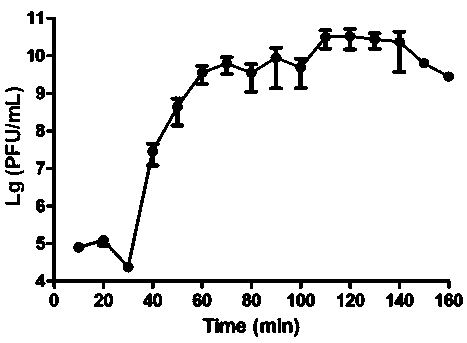Acinetobacter baumannii bacteriophage and medical application
A technology of Acinetobacter baumannii and phage, which is applied in the field of bioengineering and can solve the problems of few studies on Acinetobacter baumannii phage
- Summary
- Abstract
- Description
- Claims
- Application Information
AI Technical Summary
Problems solved by technology
Method used
Image
Examples
Embodiment 1
[0015] Phage isolation and preparation
[0016] The isolation procedure of phage is described in detail below. The sewage sample in the present invention is collected from Huoshao Li in Changchun City, and the host bacteria is Acinetobacter baumannii ABC3. Collect sewage, filter it with gauze, and replace ddH with treated sewage 2 O Prepare LB medium (100mL); add 1 mL of overnight cultured host bacteria ABC3 to the medium, and incubate at 37°C for 10-12 hours; take 1 mL of the culture, centrifuge at 12000r / min for 2 min, and filter the supernatant with a 0.22 μm filter to form phage The stock solution was kept and the resulting filtrate was used for plaque testing to check for the inclusion of phage capable of Acinetobacter baumannii ABC3.
[0017] Plaque test: inoculate Acinetobacter baumannii ABC3 in 5ml LB liquid medium at a ratio of 1%, and cultivate overnight at 37°C with shaking. Take 100 μL of the bacterial culture solution prepared above and drop it on the LB plate,...
Embodiment 2
[0020] Phage amplification and purification
[0021] On the double-layer plate forming phage plaques, use the tip of a sterile pipette to pick up a single phage plaque with a large diameter and translucency, inoculate it in 5 ml LB liquid medium, add 200 ml of phage host bacterial solution μL, shake culture at 37°C for 5 h, centrifuge at 12,000 r / min, 4°C for 10 min, and take the supernatant; repeat the double-layer plate experiment, and repeat this 4-5 times until the phages form plaques of the same size.
[0022] Take 1 mL of freshly cultured host bacteria and add 300 μL of phage lysate (the ratio of a single phage culture to host bacteria is 1:1, 1:10 and 1:100, respectively). Incubate at 37°C for 20 minutes to make the phage particles adsorb to the host bacteria; add 800mL TSB liquid medium, then add CaCl 2 The mother liquor was grown to a final concentration of 1.25mM, shaken at 37°C for 6-8h, centrifuged at 12000 r / min, 4°C for 10min, and the supernatant was taken, whi...
Embodiment 3
[0029] Transmission electron microscope observation of bacteriophage VB_AbaM_DC31
[0030] Take the PEG-purified phage in Example 2 for electron microscope observation. The specific operation steps are: add 10 μL of the sample and drop it on the copper grid, wait for it to settle for 15 min, absorb the excess liquid with filter paper, and use 2% phosphotungstic acid (PTA ) stained for 1-2min, and observed with a transmission electron microscope (Hitachi H-7650) after drying; the observation results are as follows figure 2 As shown, the head is in the shape of an icosahedron, the diameter of the head is about 35-40 nm, and the length of the tail is about 80-90 nm. According to the "Classification of Viruses—The Eighth Report of the International Committee on Taxonomy of Viruses" published by the International Committee on Taxonomy of Viruses (ICTV) in 2005, VB_AbaM_DC3 belongs to Myoviridae.
PUM
| Property | Measurement | Unit |
|---|---|---|
| Incubation period | aaaaa | aaaaa |
Abstract
Description
Claims
Application Information
 Login to View More
Login to View More - R&D
- Intellectual Property
- Life Sciences
- Materials
- Tech Scout
- Unparalleled Data Quality
- Higher Quality Content
- 60% Fewer Hallucinations
Browse by: Latest US Patents, China's latest patents, Technical Efficacy Thesaurus, Application Domain, Technology Topic, Popular Technical Reports.
© 2025 PatSnap. All rights reserved.Legal|Privacy policy|Modern Slavery Act Transparency Statement|Sitemap|About US| Contact US: help@patsnap.com



